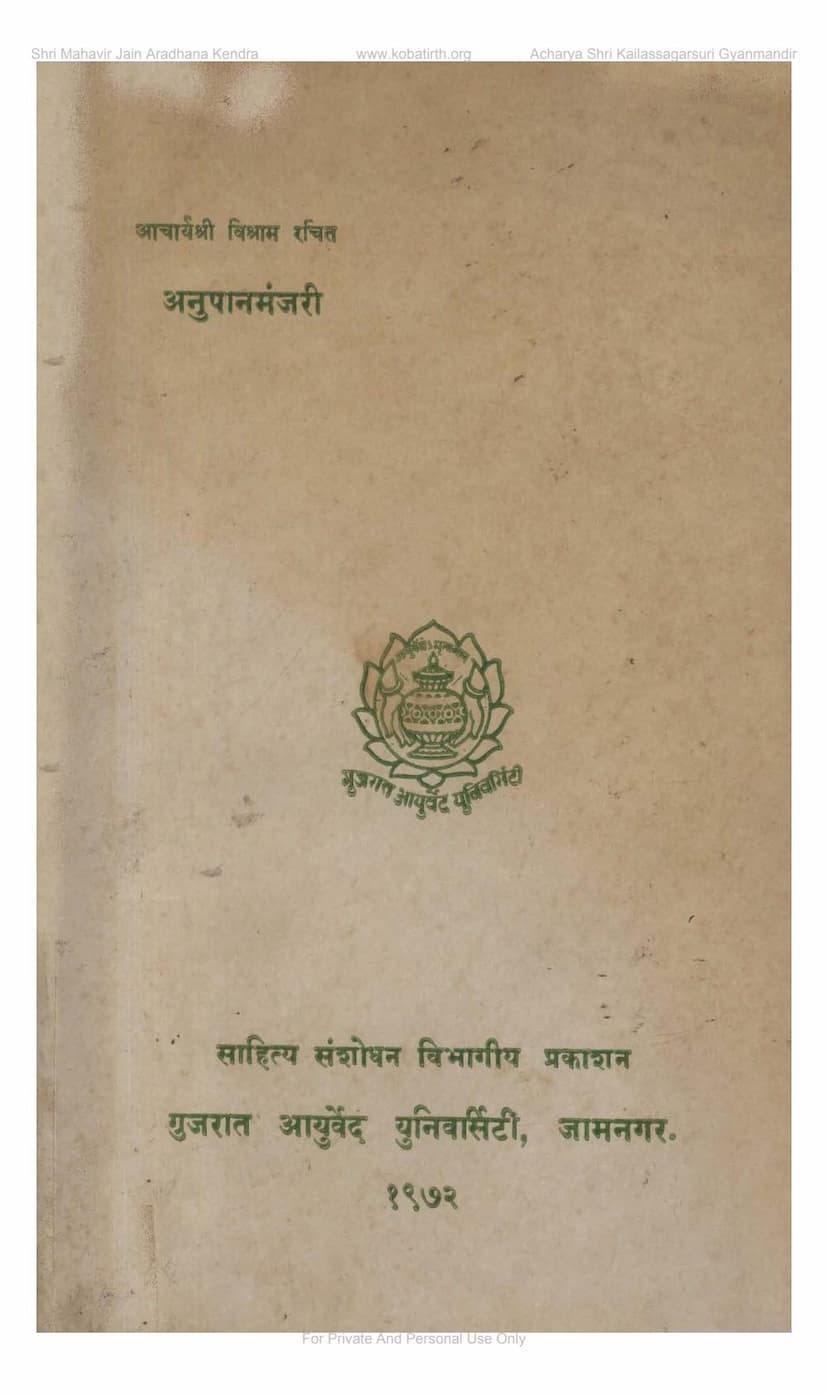Anupan Manjari
Added to library: September 1, 2025

Summary
Here is a comprehensive summary of the Jain text "Anupan Manjari" by Vishram Acharya, based on the provided pages:
Anupan Manjari: A Treatise on Antidotes and Adjuvants in Ayurveda
"Anupan Manjari," authored by Acharya Vishram, is a significant work in Ayurvedic literature focusing on the treatment of poisoning and the use of appropriate adjuvants (anupana) in medicinal preparations. Published by Gujarat Ayurved University, Jamnagar, this book represents a revival and dissemination of ancient Ayurvedic knowledge.
Background and Publication:
The publication of "Anupan Manjari" is a testament to the efforts of Gujarat Ayurved University to preserve and promote ancient Indian medical texts. The book was released on the occasion of the university's second convocation ceremony. Its publication was part of a broader initiative by the university's Department of Literary Research, established in 1969, to recover and study lost or underdeveloped branches of Ayurveda. The groundwork for this publication began earlier with the Shri Gulabkunwerba Ayurved Society in Jamnagar.
Author and His Lineage:
Acharya Vishram, the author, hailed from Anjar in the Kutch region of Gujarat. His intellectual lineage is traced within the Jain tradition, specifically to the Gorji (Guruji) Agam Gachha sect. He was a disciple of Pitambar Gorji, who in turn was a disciple of Jiva (Jivabhai) Gorji. While his guru lineage is Jain, the text itself indicates that Acharya Vishram was a Vedic follower, as evidenced by his use of Vedic invocations like "Shri Ganeshaya Namah" and "Shri Dhanvantaraye Namah." This suggests a broad intellectual and spiritual upbringing.
Content and Scope:
The primary subject matter of "Anupan Manjari" is Vishachikitsa (treatment of poison) and the proper use of Anupana (adjuvants). The book is structured into five sections (Samuddeshas), systematically detailing various aspects of toxicology and therapeutics:
-
Chapter 1: Dhatu Vikar Shanti (Treatment of Metal-Related Disorders): This section addresses disorders arising from the ingestion or improper use of metals. It describes specific remedies for ailments related to gold, silver, copper, lead, tin, zinc, and iron, often employing herbal and mineral-based compounds. The remedies are presented with poetic similes to highlight their efficacy.
-
Chapter 2: Updhatu Vikar Shanti (Treatment of Updhatu-Related Disorders): This chapter focuses on disorders caused by the misuse of "Updhatus," which are secondary metallic or mineral substances in Ayurvedic classification. It details treatments for conditions arising from mercury, purified sulfur, talc, manashila, copper sulfate, alum, and other such substances. The significance of mercury as an Updhatu is noted, along with treatments for its associated toxicities.
-
Chapter 3: Stavar Vish Shanti (Treatment of Stationary Poisons): This section deals with poisons originating from plants and stationary sources. It covers remedies for poisoning from substances like opium, datura, aconite, marking nut, cannabis, and various other toxic plants. Some of these substances were becoming more known during Acharya Vishram's time, possibly due to increased interaction with other cultures.
-
Chapter 4: Jangam Vish Shanti (Treatment of Mobile Poisons): This chapter addresses poisons from mobile sources, primarily animal bites and infestations. It provides treatments for snake bites, scorpion stings, dog bites, and other venomous creatures. It also includes remedies for insect infestations and hygiene-related issues like lice and bedbugs, showcasing a comprehensive approach to toxicological concerns.
-
Chapter 5: Dhatu-Updhatu Maran and Roganupana (Purification and Incineration of Metals/Updhatus and Adjuvants for Diseases): This final and most extensive chapter focuses on the processes of Shodhan (purification) and Maran (incineration/pulverization into ash) of metals and updhatus, crucial steps in preparing potent Ayurvedic medicines. It details specific methods for purifying and incinerating various metals and updhatus like iron, tin, lead, zinc, mercury, mica, and minerals like orpiment and realgar. It also extensively lists various Anupanas (adjuvants) like decoctions, milk, honey, ghee, and specific food items to be taken with different medicines for various diseases, demonstrating the author's deep understanding of therapeutic principles.
Key Features and Contributions:
- Focus on Anupana: The book's title itself highlights the importance of "Anupana," emphasizing that the correct adjuvant can enhance the efficacy of a medicine, aid its absorption, and counteract potential adverse effects.
- Detailed Classification: Acharya Vishram presents a unique classification of mineral substances into "Dhatus" and "Updhatus," which differs from some earlier Ayurvedic texts. He also categorizes poisons into stationary (Sthavar) and mobile (Jangam).
- Practical Remedies: The text provides specific recipes and dosages for various treatments, drawing from both traditional Ayurvedic knowledge and, in some instances, possibly local or empirical observations.
- Integration of Philosophy and Medicine: The author uses poetic similes and philosophical allusions to describe the effectiveness of treatments, linking them to spiritual or moral benefits, such as the removal of sins or the overcoming of poverty.
- Scholarly Apparatus: The publication by Gujarat Ayurved University includes extensive introductory and concluding sections, detailed appendices listing substances, diseases, and their corresponding adjuvants, and comparative analyses with other Ayurvedic texts. This scholarly framework enhances the accessibility and credibility of the work.
- Linguistic Nuances: The text's original language is Sanskrit, but it includes Gujarati translations of verses and is accompanied by a Hindi translation for wider accessibility. The use of regional Gujarati terms within the Sanskrit text and their subsequent Sanskritization by the author further highlights his connection to Gujarat.
Significance:
"Anupan Manjari" is valuable for its detailed exploration of toxicology and its practical remedies. It sheds light on the specific contributions of Gujarati scholars to Ayurvedic literature and underscores the continuous evolution and adaptation of Ayurvedic principles. The book serves as a vital resource for researchers, practitioners, and students of Ayurveda interested in the treatment of poisoning and the nuanced application of adjuvants in therapy. The extensive appendices provide a valuable reference for understanding the materia medica and therapeutic strategies of the period.